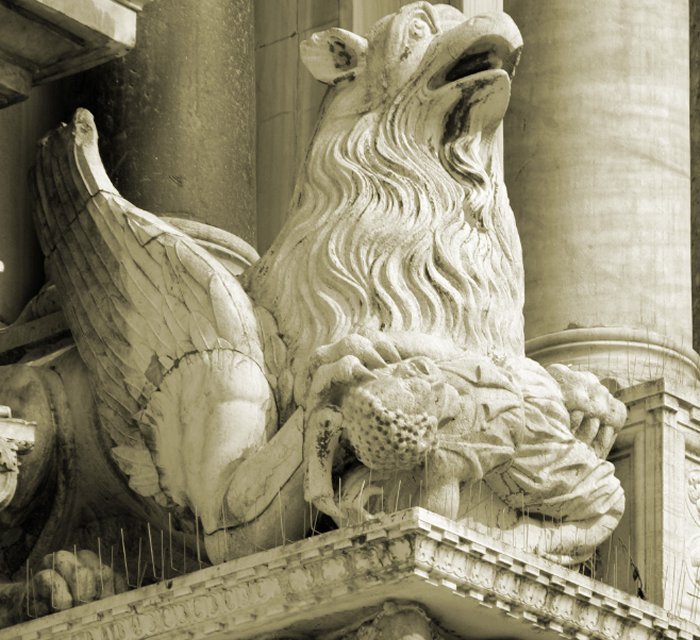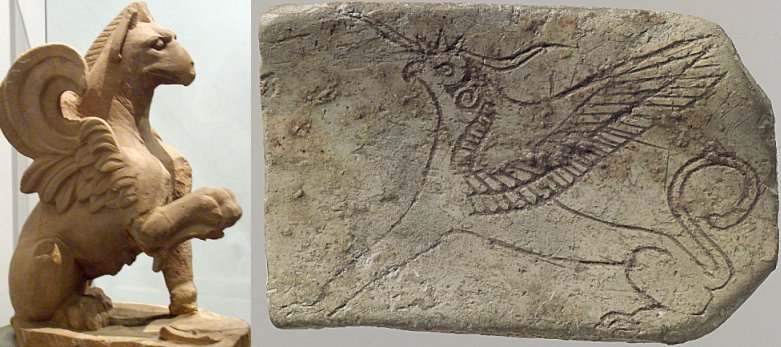Griffins Were Mythical Gold-Guarding Hybrid Creatures Known For At Least 5,000 Years
A. Sutherland - AncientPages.com - If you were to ask a random passerby on the street what the most fantastic creatures are, they would undoubtedly say - griffin, among others.
At least five thousand years old, a mythical hybrid animal known as 'griffin' had the body of a lion and head, sharp claws, and snow-white or golden wings of the eagle.
A statue of a griffin on the Basilica di S. Marco. source
These magical beings symbolized power over heaven and earth, vigilance, strength, and pride. They became an attribute of the Nemesis goddess of retribution, often depicted in a chariot drawn by griffins. This creature used to turn her wheel of fortune. It is one of the oldest magical creatures, which today remains a powerful protector of modern civil institutions such as banks, car plants, and breweries in many countries. It is used in heraldry and appears widely as school sports team mascots and various insignia.
Intelligence, strength, and majesty of the lion that was long ago proclaimed "King of the Beasts" and the superiority of the eagle, the "King of the Air," are combined in the mysterious griffin creature.
"In Sumerian myth, the griffin is the mount of the weather god, Iskur, where it is depicted vomiting forth streams of water or lightning from its mouth upon the parched land. In Assyrian art, the griffin is frequently shown venerating and protecting the Tree of Life, as well as flanking divine figures to assist the check of evil…" 1
Tradition Has It Griffins Were Born In Ancient East
They appeared in ancient Assyria and soon became known almost everywhere, from China to the Himalayas, Persia to Egypt. During the Fifth Dynasty, the Pharaoh himself was depicted as a griffin, successfully fighting the enemy, and this representation symbolized the power of the ruler.
In Egyptian mythology, the griffin is a lion (king) and a falcon, a symbol of the god Horus. We can trace Egyptian influence to the Minoan culture, which gave the griffin creature the qualities of a great warrior.
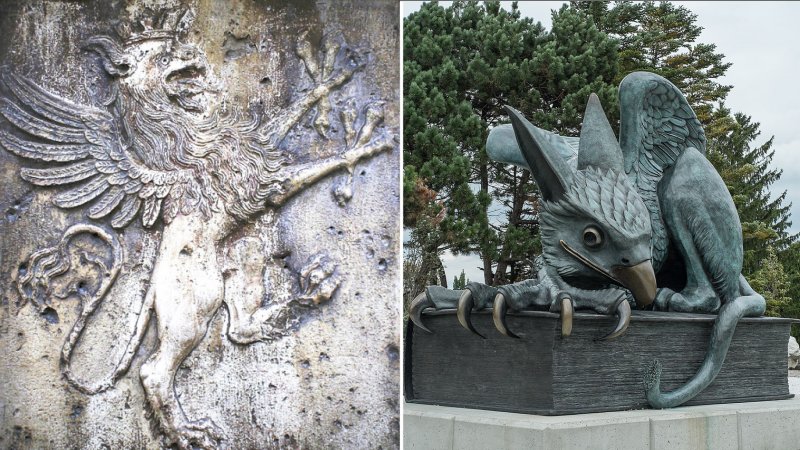 Left: Griffin segreant wearing the mural crown of Perugia, 13th century, source; Right: The Gryphon is the emblem and mascot of the University of Guelph, source
Left: Griffin segreant wearing the mural crown of Perugia, 13th century, source; Right: The Gryphon is the emblem and mascot of the University of Guelph, source
The griffin became a popular decorative motif in the ancient Middle East and Mediterranean region. The applied tapestries frequently used a griffin motif, as did goldsmiths in their art. This hybrid appears in animated films, fantasy novels, and computer games.
Representations of griffin-like hybrids with four legs and a beaked head appeared in Iran's ancient art since the late 2nd millennium BC. In Iranian mythology, the griffin is called Shirdal, which means "Lion-Eagle," and was displayed on old cylinder seals from Susa as early as 3000 BC. Shirdals also are common motifs in the art of Luristan, the North and North West region of Iran in the Iron Age, and Achaemenid art.
Depictions of griffin-type creatures dated about 1950–1550 BC accompanied people in the Levant, Syria, and Anatolia in the Middle Bronze Age.
Early depictions of griffin-types in ancient Greek art date back to the 15th century BC; a good example can be frescos in the Throne Room of the Bronze Age Palace of Knossos.
Griffins In Greece Were Bearers Of The Soul
In the 7th century BC, the ancient Greeks made the first contact with the nomadic people of Central Asia. They also encountered some most fascinating creatures like griffins.
Left: Saqqara, Alexandria National Museum; Right: Furniture plaque: incised griffin, ca. 18th century BC Old Assyrian Trading Colony. Source
In the Scythian myths and legends recounted in Greek and Roman texts, griffins were associated with gold, and so were the mysterious Arimaspians.
The existence of griffins is mentioned in the first literary work, "Arimaspea," by the Greek Aristeas of Proconnesus in 675 BC.
We also encounter them in the lore of ancient Greece and art, as the artists adopted them to decorate vases, seals, mosaics, lyres, gems, coins, and reliefs, but they appear primarily to have been carved upon tombs to guard the dead and to act as bearers of the soul.
The representations of griffins were also common in Egyptian and Persian art, and their impressive, powerful statues decorated Persian palaces.
The griffins were extremely strong and dangerous. They inhabited desert areas, including which China and Mongolia and the regions of the Altai Mountains, the Tien Shan, and the Gobi desert. According to Greek myths, they guarded Apollo's treasure in the Scythian desert and protected him from the legendary Hyperborean tribe of the far north that inhabited the area.
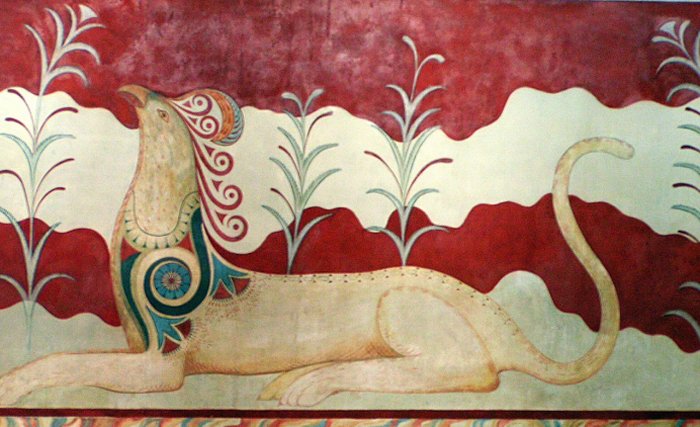 Knossos fresco in throne palace. source
Knossos fresco in throne palace. source
"In the 5th century BC, the Greek writer Herodotus related a story about a one-eyed people known as the Arimaspians who wrested their immense wealth of gold from griffins. He learned this tale from a mysterious traveler, Aristeas of Proconnesus, who told how the griffins guard the gold of the northern lands of Scythia. 1
The same myths tell these divine creatures also guarded the gold of the Hyperboreans of the far north and used to pull the chariot of Apollo and Zeus himself and the goddess of vengeance, Nemesis.
Griffin And Christianity
At first, this mythical animal was identified with evil and even with the Antichrist himself. Depicted as a satanic figure, it had surprisingly very easy to entangle human souls. Over time, however, the griffins' negative symbolism changed and symbolized two aspects of Jesus Christ's dual nature- the divine and the human.
As the last scholar of the ancient world, Isidore of Seville (570-636) wrote in "Etymology":
"Christ is a lion, for he reigns and has power; he is an eagle, for after the resurrection he ascends to heaven."
Ancient people considered the griffin to be a symbol and protector of divine power and, therefore, the king of all creatures, which was a fierce opponent of serpents (snakes) and basilisks, both of which were considered the personification of satanic demons.
Updated on June 5, 2024
Written by – A. Sutherland - AncientPages.com Senior Staff Writer
Copyright © AncientPages.com All rights reserved. This material may not be published, broadcast, rewritten or redistributed in whole or part without the express written permission of AncientPages.com
Expand for referencesReferences:
Eberhart George M. Mysterious Creatures: A Guide to Cryptozoology - Volume 1
1. Matthews, J., Matthews, C. The Element Encyclopedia of Magical Creatures
More From Ancient Pages
-
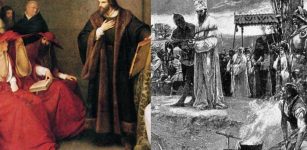 Jan Hus: Czech Reformer And Bohemian Religious Leader Was Burned At Stake For Heresy
Featured Stories | Dec 17, 2019
Jan Hus: Czech Reformer And Bohemian Religious Leader Was Burned At Stake For Heresy
Featured Stories | Dec 17, 2019 -
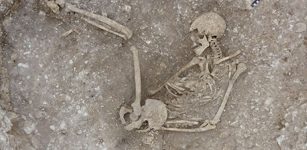 Unusual Iron Age Cemetery Discovered In Dorset, UK
Archaeology | Jul 11, 2022
Unusual Iron Age Cemetery Discovered In Dorset, UK
Archaeology | Jul 11, 2022 -
 New Moai Statue Found On Easter Island
Archaeology | Feb 28, 2023
New Moai Statue Found On Easter Island
Archaeology | Feb 28, 2023 -
 Rare Well-Preserved Viking Artifacts Lost On Mountain Pass – Revealed By Retreating Glaciers
Archaeology | Apr 16, 2020
Rare Well-Preserved Viking Artifacts Lost On Mountain Pass – Revealed By Retreating Glaciers
Archaeology | Apr 16, 2020 -
 Ancient Jaintia Kingdom And The Garden Of Monoliths And Dolmens
Featured Stories | Nov 8, 2016
Ancient Jaintia Kingdom And The Garden Of Monoliths And Dolmens
Featured Stories | Nov 8, 2016 -
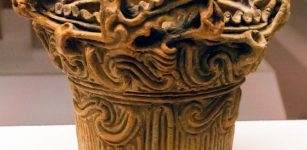 Surprising New Insights Into Use And Increased Production Of Pottery At The End Of The Last Ice Age
Archaeology | Mar 22, 2016
Surprising New Insights Into Use And Increased Production Of Pottery At The End Of The Last Ice Age
Archaeology | Mar 22, 2016 -
 Undiscovered Neanderthal Artifacts From The Ice Age Are Submerged Below The Waves Of The English Channel
Archaeology | Nov 23, 2022
Undiscovered Neanderthal Artifacts From The Ice Age Are Submerged Below The Waves Of The English Channel
Archaeology | Nov 23, 2022 -
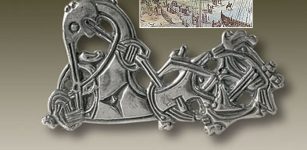 Kaupang – Flourishing Viking Town – A Commercial Hub And Transit Port For North Sea Trade
Featured Stories | Feb 2, 2023
Kaupang – Flourishing Viking Town – A Commercial Hub And Transit Port For North Sea Trade
Featured Stories | Feb 2, 2023 -
 The Hobbit – An Ancient Hominin Species May Still Be Living In The Forests Of Flores Island – Anthropologist Says
Archaeology | Apr 20, 2022
The Hobbit – An Ancient Hominin Species May Still Be Living In The Forests Of Flores Island – Anthropologist Says
Archaeology | Apr 20, 2022 -
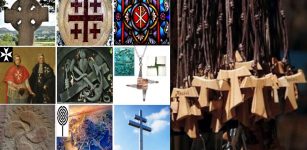 10 Types Of Ancient Crosses In Different Cultures Explained
Featured Stories | May 23, 2017
10 Types Of Ancient Crosses In Different Cultures Explained
Featured Stories | May 23, 2017 -
 Ancient Tomb Of William The Conqueror’s Nephew Discovered In Exeter
Archaeology | Aug 1, 2023
Ancient Tomb Of William The Conqueror’s Nephew Discovered In Exeter
Archaeology | Aug 1, 2023 -
 On This Day In History: Battle Of Pinkie Was Fought – On September 10, 1547
News | Sep 10, 2016
On This Day In History: Battle Of Pinkie Was Fought – On September 10, 1547
News | Sep 10, 2016 -
 Prehistoric House Of The Dead Discovered In Wiltshire – Is This The Burial Place Of Ancestors Of Stonehenge Builders?
Archaeology | Jul 17, 2017
Prehistoric House Of The Dead Discovered In Wiltshire – Is This The Burial Place Of Ancestors Of Stonehenge Builders?
Archaeology | Jul 17, 2017 -
 Was Beautiful Ancient City Of Terracina Home To The First Hellenistic Temple?
Archaeology | Dec 16, 2019
Was Beautiful Ancient City Of Terracina Home To The First Hellenistic Temple?
Archaeology | Dec 16, 2019 -
 Rare 3,000-Year-Old Gold Bead Found On Temple Mount By Young Boy
Archaeology | Nov 30, 2020
Rare 3,000-Year-Old Gold Bead Found On Temple Mount By Young Boy
Archaeology | Nov 30, 2020 -
 Excavations At Okazaki Castle Reveal A 400-Year-Old Massive Unbroken Wall
Archaeology | Apr 16, 2016
Excavations At Okazaki Castle Reveal A 400-Year-Old Massive Unbroken Wall
Archaeology | Apr 16, 2016 -
 We Dated A Sacred Aboriginal Women’s Site Used for Birthing Ceremonies And Discovered 7,000 Years Of Tool Making
Featured Stories | Jun 21, 2024
We Dated A Sacred Aboriginal Women’s Site Used for Birthing Ceremonies And Discovered 7,000 Years Of Tool Making
Featured Stories | Jun 21, 2024 -
 A 1,000-Year-Old Intact Mummy Unearthed In Ancient Pachacamac Site, Peru
Archaeology | May 31, 2018
A 1,000-Year-Old Intact Mummy Unearthed In Ancient Pachacamac Site, Peru
Archaeology | May 31, 2018 -
 Evidence For A Divergence Between Eastern And Western Mediterranean Indo-European Languages Finally Provided By Ancient Genomics Study
Archaeology | Jan 4, 2025
Evidence For A Divergence Between Eastern And Western Mediterranean Indo-European Languages Finally Provided By Ancient Genomics Study
Archaeology | Jan 4, 2025 -
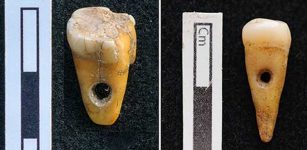 Rare Discovery Of 8,500-Year-Old Human Teeth Used As Jewelry
Archaeology | Dec 16, 2019
Rare Discovery Of 8,500-Year-Old Human Teeth Used As Jewelry
Archaeology | Dec 16, 2019

